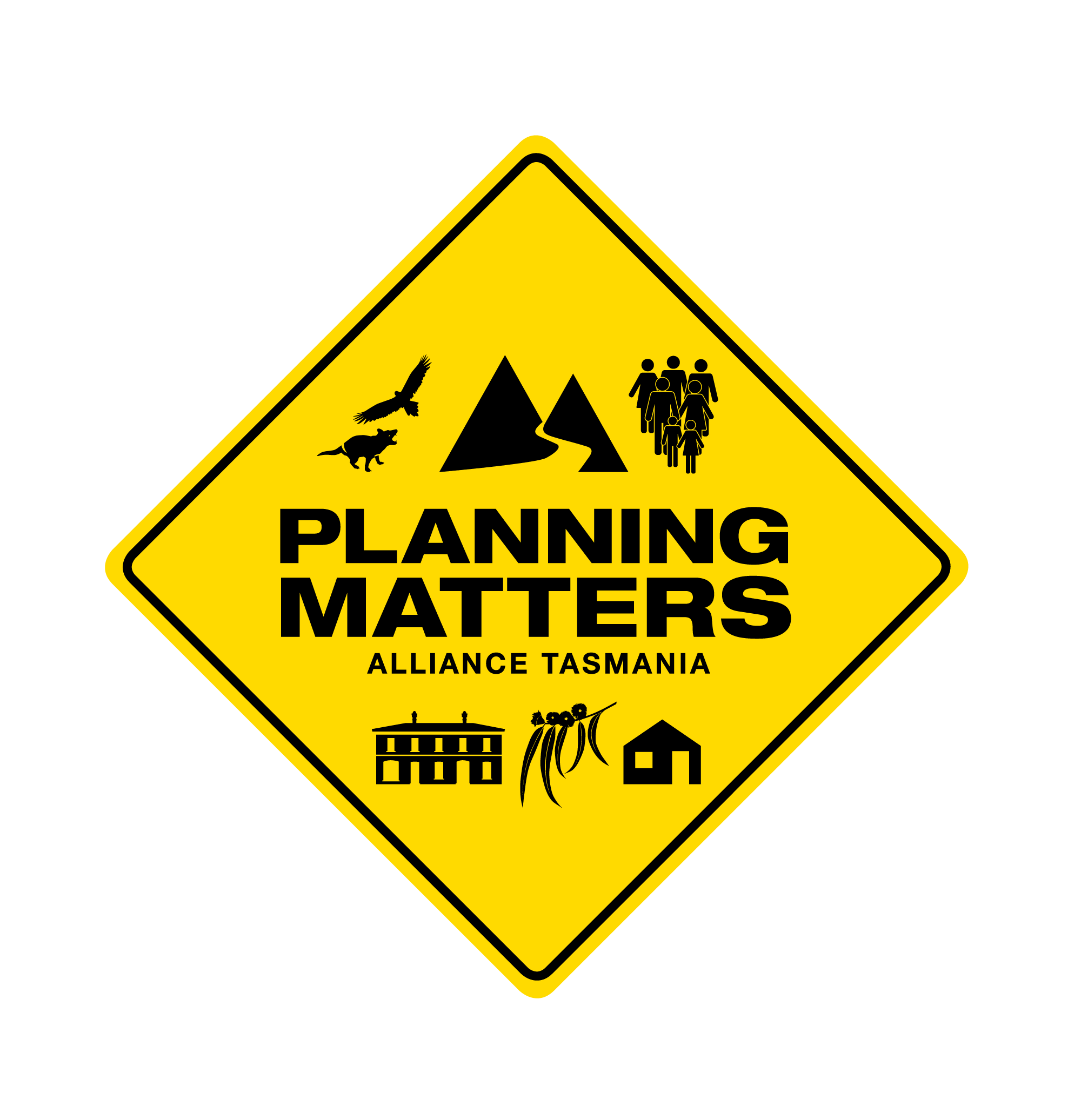- Submission
Draft Tasmanian Planning Policies
Media Enquiries
Sophie Underwood
PMAT State Director
sophie_underwood@hotmail.com
0407 501 999
Please share:
Phase 2 of the State Government’s planning reform is underway and includes a review of the State Planning Provisions (SPPs), introduction of the Tasmanian Planning Policies (TPPs), the creation of a regional land use planning framework, and a review of the three Regional Land Use Strategies (RLUS).
The SPPs will also require review for consistency with the Tasmanian Planning Policies once they are finalised.
The Planning Matters Alliance Tasmania (PMAT) thanks you for the opportunity to comment on the Draft Tasmanian Planning Policies. We would welcome the chance to be involved in any stakeholder workshops or other consultations dealing with finalisation of the TPPs in the lead up to the proposed submission to the Tasmanian Planning Commission in 2023.
General Comments
PMAT supports the development of the TPPs as much needed strategic level guidance for the Tasmanian Planning System. While our preference remains for a fully developed set of State Policies as the primary instrument for providing strategic guidance on planning, we welcome the draft TPPs as going some way towards implementing a strategic framework. To be effective the TPPs do need to be informed by, and deliver on, the LUPAA objectives and State Policies.
The TPPs need to drive on the ground operation of the Tasmanian Planning System through the SPPs, RLUSs and LPSs – they should not just reflect/reinforce current arrangements. It is regrettable that the SPPs have already been developed without guidance of the TPPs, although it is acknowledged that the current SPP review will consider their alignment with the TPPs, once finalised.
Design and Implementation
There is a risk that if not properly designed and implemented the TPPs will add to the complexity and uncertainty of the TPS without providing the benefits of strategic direction.
While there are many positive statements in the draft TPPs, without clear implementation pathways it is difficult to see how these will translate into positive outcomes:
- Apart from general commitment to ‘align’ SPPs/RLUSs with TPPs as apart of current reviews it is not clear how this will in fact be done in a way that ensures meaningful change to achieve TPP objectives.
- While there is provision for Implementation Guidelines in the TPPs generally these have not been included in most of the current draft TPPs. Because all TPPs are to carry equal weight there is a risk of conflict and confusion in application unless there are implementation guidelines to provide direction and help address potential inconsistencies.
Major Projects
Paragraph 1 of the Foreword, Draft Tasmanian Planning Policies, states that “the Act requires consideration of TPPs during declaration and assessment of major projects”. A stronger requirement for Major Projects assessments to comply with TPPs would give the community more confidence that such assessments would be undertaken within a proper strategic framework.
Climate Change
PMAT acknowledges the effort made by the State Planning Office to try to accommodate comments made by PMAT and other groups into the content of the draft TPPs. However, the small final set of draft TPPs has meant that some significant issues receive less prominence than required. In particular, PMAT is concerned that the importance of climate change to all aspects of the TPS will not be properly reflected by simply including a separate Climate Change Statement in each TPP. As proposed in its submission on the 2021 Scoping Paper for draft TPPs, at minimum, we would like to see the creation of a specific climate change TPP with overarching application, linked into all other relevant TPPs, to ensure reduction of emissions of greenhouse gases, and mitigation of the impacts of the climate crisis and disruption on the Tasmanian community. Given the enormity and importance of climate change, the development of a Climate Change SP is also essential.
Language
The language used in the TPPs should be reviewed – especially within the Strategies – so that plain English is used and interpretation is made easier. At the same time, weak and ambiguous terminology in some TPP Strategies will need to be strengthened if these are to be an effective tool in providing strategic guidance to the TPS. Some examples of where these changes are required are included in our specific comments below.
Review and evaluation
There is a requirement under LUPAA for TPPs to be reviewed five yearly. However, the TPPs currently do not contain a section on evaluation and performance measures that would establish the review framework and facilitate assessment of how effectively the TPP has achieved its objectives.
Establishment of such measures (and benchmarks) and supporting data collection systems at an early stage is a better approach than attempting to retrospectively collect the necessary information.
Monitoring, evaluation and reporting should also be linked to State of the Environment Reporting both at the State and National level.
Under the State Policies and Projects Act 1993 Tasmania must release a State of the Environment Report (SoE) every five years and the Minister must table it in Parliament. So far, three Tasmanian State of the Environment reports have been prepared: 1997, 2003 and 2009. The SoE reports provide a strategic view to shape policy and action. The next Tasmanian SoE report is overdue, but the Tasmanian Government has committed to releasing a report by June 2024. PMAT welcomes the decision to allow the SoE report to continue to be prepared by the Tasmanian Planning Commission.
The Australian Government also conducts a comprehensive review of the state of the Australian environment based on twelve environmental themes: Air quality, Antarctica, Biodiversity, Climate, Coasts, Extreme events, Heritage, Indigenous knowledge, Inland water, Land, Marine and Urban environments. The report is a comprehensive assessment of the state of Australia’s environment that is produced every five years by the Australian Government. The next National SoE report is due in 2026.
Specific Comments relating to individual TPPs
1.0 Settlement
- Recent experience has seen strong population growth driving settlement expansion – actively promoted by government population policy. The Growth topic (1.1) assumes this will continue and that it will be supported by communities. While it may be the case in the short term, such growth is unlikely to be sustainable in the medium to long term without seriously degrading the environment, liveability and the Tasmanian brand.
It is recognised that population policy is strictly speaking outside the scope of the planning system. Nevertheless, the current review of Tasmania’s Population Growth Strategy needs to consider the capacity of the planning system and infrastructure to support continuing high growth levels without further substantial harm to the environment and the living standards of Tasmanians.
- At the same, The TPPs should allow some flexibility in the planning system for communities to have a say in population growth – or decline – in their area; and provide planning strategies to support this.
- Strategy 1 under 1.1 Growth seeks to maintain a 15 year land supply to meet existing and forecast community demand. There is no clear rationale provided for this 15 year goal and it is uncertain how existing sub-division approvals will be prioritised for development before attempting to allocate new land. While much of the intent of Strategies 2 to 12 is supported, they should more strongly make moving beyond urban growth boundaries a last resort where all other development options have been exhausted.
- Affordable housing is a critical issue currently affecting many Tasmanians. The planning system is only one of a number of factors (and indeed not a major factor) influencing access to affordable housing. Although topic 1.5 Housing does touch upon the issue there is scope to better address affordable and social housing provision– for example by mandating that new developments should contain a proportion of social and/or affordable housing. It is understood that a mandated level of at least 10% social housing (or equivalent developer financial contribution) is a model that has been successfully adopted elsewhere.
2.0 Environmental Values
- PMAT considers that Tasmania has had a poor record in applying legislation to protect the environment which makes it even more important that planning policies establish clear, enforceable measures for this purpose. The objectives of the TPP and strategies across the five topics fall short on achieving this. Furthermore, there is a clear priority given to economic over environmental values.
Some specific examples include:
2.01. Principles and Policy Objectives
- The second paragraph refers to “healthy ecosystems and intact landscapes to produce goods and services that stimulates our economy “. Arguably stimulating the economy is not the primary purpose of the environment. It is suggested that “that stimulates our economy” be omitted.
- Principles 3 and 4 seem fairly weak. At the very least offsets should be required where impacts cannot be minimised. • Strategy 5 should be strengthened so that development which impacts on biodiversity values should only occur under exceptional circumstances where it has been demonstrated that there is a strong public interest in proceeding and suitable offsets are available.
2.1 Biodiversity
2.2 Waterways, Wetlands and Estuaries.
- • Strategy 2a) should be strengthened to read ‘relies specifically on being located within close proximity to aquatic environments and has stringent controls on pollution and disturbance.’ • The Strategy 4(e provision for ‘not significantly’ increasing the rate and quantity of stormwater or pollutants entering the water does not provide sufficient protection. Rather than ‘not significantly’ this should be ‘only involve a minimal’. Alternatively there could be a requirement to demonstrate no degradation of water quality as a result of the development.
2.3 Geodiversity
- Strategy 1 should perhaps make reference to the Tasmanian Geoconservation database, pending availability of better mapping to identify high conservation value geodiversity. • Strategy 2. Rather than allowing damage where ‘not practicable’, this should be strengthened so that minimisation occurs when protection is ‘demonstrably unavoidable’.
2.4 Landscape values
- Avoiding fragmentation of landscapes should be a priority. In Strategy 3b) substituting ‘overriding’ for ‘considerable’ would better protect landscape values.
2.5 Coasts
- Objective 2.5.2 should refer to natural coastal values.
- Strategy 3 refers to identifying “coastal areas that can support the sustainable use and development of recreation, tourism, boating infrastructure (jetty wharfs), marine industries, ports and other land use that explicitly rely on a coastal location while
- minimising the impacts on coastal values.” Encouraging such new development sites will add to the degradation of the coastal zone and encourage undesirable ribbon development. This also runs counter to strategies in the Settlement TPP that promote infill within existing settlements.
PMAT is of the view that Strategy 3 should be removed or alternatively be reworded to allow such development locations only in exceptional circumstances.
3.0 Environmental Hazards
3.0.1 Principles and Policy Context
- Principle dot point 7 (p25) requires hazard mitigation measures to consider the impacts on other values. Better protection for such values would be provided if the principle referred to ‘seeking to minimise’ rather than just considering.
3.0.2 Climate change statement.
- •The opening paragraph lists potential climate change hazards, but appears to omit storms/wind.
3.1 Bushfires
- Strategy 8a) should be reworded to “priority should be given to minimising the impact of future bushfire protection measures on the environment and the cost to the community of defending properties from bushfire.”
3.4 Coastal Hazards
- Strategy3a) Should read ‘dependent on a coastal location and the risk can be managed’
4.0 Sustainable Economic Development
- A better title for this TPP is ‘Sustainable Development’. The emphasis and terminology in the LUPAA objectives is on sustainable development. While the LUPAA objectives do refer to economic development, they also indicate that “facilitation of economic development” must be in accordance with objectives (a), )b) and (c) in the Act. Removing ‘economic’ from the title would mean that this TPP is better aligned with the LUPAA objectives.
4.2 Extractive industry
- To be consistent with the LUPAA objectives the Objective of this topic should refer to ‘sustainable development’ rather than ‘economic growth’.
- Strategy 3 should be conditional so as to provide a balanced approach across the set of TPPs. It is suggested that it be amended to read ‘Support the long-term viability of existing operations and access to future mineral resources where this is compatible with the objectives of the Act and other TPPs.’
- Given historical experience and future potential for severe environmental damage from extractive industries it is proposed that Strategy 6e) be amended to read ‘environmental impacts are minimal and planning provides for future rehabilitation and alternatives uses of the mine site.’
4.3 Tourism
- This TPP recognises the value of tourism to Tasmania, but also the negatives that can arise from the impacts of increasing visitor accommodation and the cumulative use by tourists of local facilities that can detract from the quality of life of local residents and cultural and environmental values. Planning could be used to remedy these impacts but implementation guidelines are not provided.
- Strategy 4 should be amended to better protect the values that are important to the Tasmanian brand and sustainable tourism, as follows: ‘Support unique, diverse and innovative tourism experiences that support the Tasmanian brand in a way that does not risk long term harm to the brand and the tourism industry.’
- The use of the term ‘unreasonably’ in Strategy 7 is problematic. Protecting local community values should take precedence over tourism where there is a conflict and it is proposed that the word ‘unreasonably’ be removed or else that the strategy be recast to better protect communities from the cumulative effects of tourism.
4.4 Renewable Energy
- Strategy 1. b) should also take into account the impact on communities. The alternative wording ‘economic and social value and impact on communities;’ is proposed.
4.6 Business and Commercial
- Strategy 1. 3) might be better worded as ‘access to workforce’.
- Strategies 7 and 8 (p41) are aimed at providing guidance for allowing home-based businesses and new commercial opportunities in residential areas. While the intent of these provisions could provide benefits to communities, it should be recognised that residential amenity should take precedence in such considerations. There is also a risk that these provisions could undermine current zoning provisions. For this reason the following changes are proposed:
- − Strategy 7 be amended to: ‘Support home-based businesses where it is demonstrated that the impact causes no loss of residential amenity to the surrounding area.’
- − Strategy 8 be amended to: ‘Provide for small scale commercial or business opportunities in residential and industrial areas that meets the needs of local residents or workers, is conveniently located and, in the case of residential land, causes no loss of residential amenity and is supported by evidence that residents agree with such development.’
5.0 Physical Infrastructure
- The critical role played by infrastructure in maintaining the health and wellbeing of our community is recognised, as is the importance of infrastructure development being part of the planning process. It is important that local communities have input into the planning of physical infrastructure at an early stage of the process, both to help make sure that the infrastructure meets community needs and to minimise any adverse effects during construction. Environmental impacts of providing physical infrastructure should also be minimised.
5.1 Provision of Services
- In order to ensure environmental impacts are properly considered, Strategy 3 should be amended to ‘….. the most logical and cost-effective solution to deliver services to growth areas while minimising cultural and environmental impacts’.
5.2 Energy Infrastructure
- PMAT proposes adding an additional Strategy 5 ‘Encourage local self-contained energy solutions that reduce network dependence and load.’ Such local solutions can help minimise both energy costs for local communities and overall network cost overheads.
5.3 Roads
- Strategy 4 should be amended to read ‘Support heavy vehicle access that is responsive to industry needs and appropriate to the condition, current use and function of a road, and that allows impact on existing residential amenity and the environment to be minimised.’
- Strategy 6 as currently worded appears to make road investment the driver of planning decisions. This strategy should be reworded to make clear the primacy of the planning system in determining land use.
- Consider creating a new topic 5.4 Streets. The Street should be included in the TPPs. Currently the street effectively sits outside the planning system. But it is the street that connects us all both within suburbs and between suburbs. In PMAT’s submission on the review of the SPPs, we called for the creation of a new Liveable Streets Code. In particular, our SPP submission argued to insert a Liveable Streets Code to acknowledge the importance of the streetscape and public space. The purpose of the code is to impose requirements which results in streets supporting the wellbeing and liveability of Tasmanians and increase the urban forest canopy. The code would provide for appropriate standards for development of a streetscape at the subdivision stage or where a government body is constructing a new residential street. It is also important to note that the peak Tasmanian health organisation, the Heart Foundation, also called in its in its ‘Heart Foundation Representation to the final draft State Planning Provisions 7 March 2016’, for the creation of a Street Code.
6.0 Cultural Heritage
6.1 Aboriginal cultural heritage
- PMAT has long been concerned about the inadequate provision within the TPS to take into account and protect Aboriginal cultural heritage. The inclusion of topic 6.1 within this TPP is therefore strongly supported, subject to its form and content being determined by the Aboriginal community.
6.2 Non-Indigenous Cultural Heritage
- The adaptive re-use of non-indigenous cultural heritage is in many cases important to ensuring the long term retention of such heritage structures. With this in mind it is suggested that the Objective for this topic be reworded to read: ‘To support the identification and conservation of significant non-Indigenous local cultural heritage buildings, parts of buildings, infrastructure (for example bridges), places, precincts and landscapes and promote design responses that preserve cultural heritage values while allowing adaptive reuse wherever possible.’
More Submissions

PMAT Submission: Draft LUPA Amendment (Development Assessment Panels) Bill 2024
All the issues raised in PMAT’s 2023 submission on the Position Paper on a proposed DevelopmentAssessment Panel (DAP) Framework still stand. The Tasmanian Government has

ACS Submission: Review of the State Coastal Policy – Development of Actively Mobile Landforms Position Paper
Australian Coastal Society (Tasmania) Submission on Review of the State Coastal Policy – Development of Actively Mobile Landforms Position Paper.

PMAT Submission Coastal Policy Position Paper 2024
PMAT Submission: Review of the State Coastal Policy – Development of Actively Mobile Landforms Position Paper

PMAT Submission: Improving Residential Standards in Tasmania, Draft Report July 2024 and associated Medium Density Design Guidelines
PMAT’s founding platform seeks to improve the liveability and wellbeing of all Tasmanians.
One of PMAT’s founding concerns was the poor residential standards of

Support Us
Receive News & Updates from PMAT
Stay informed on what’s happening locally and statewide within Tasmania, and join our community in advocating to protect Tasmania’s future.